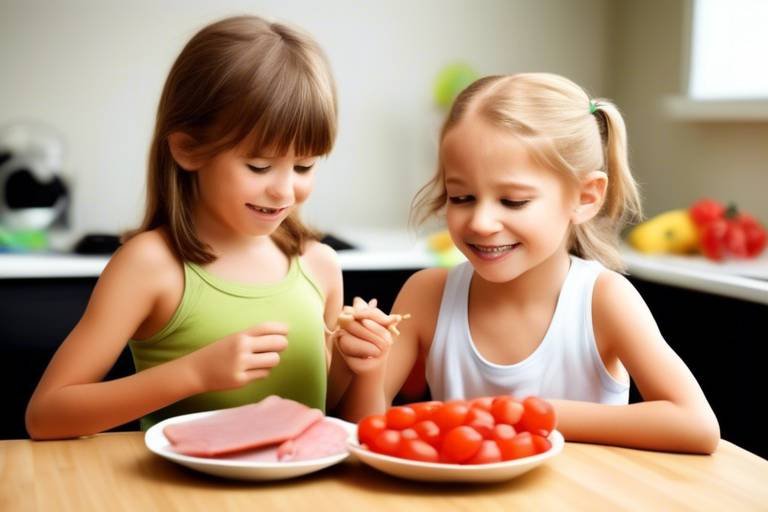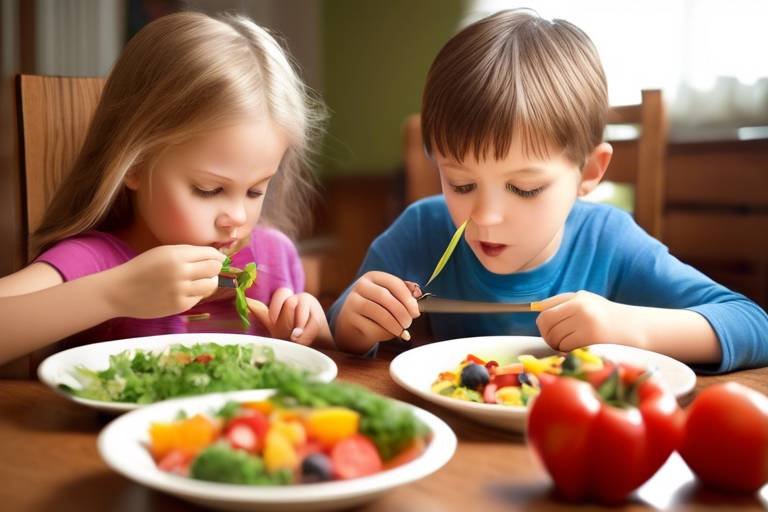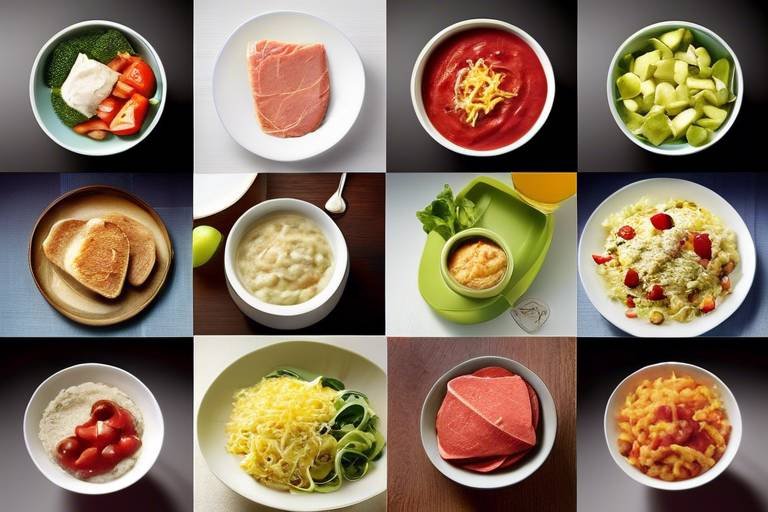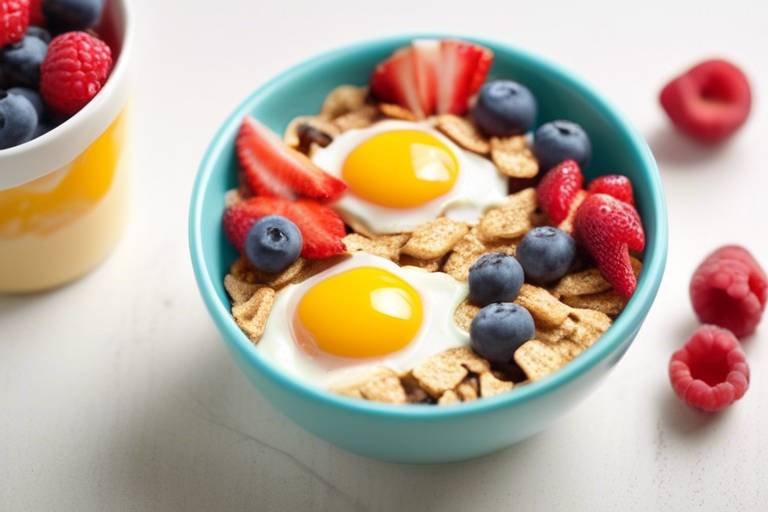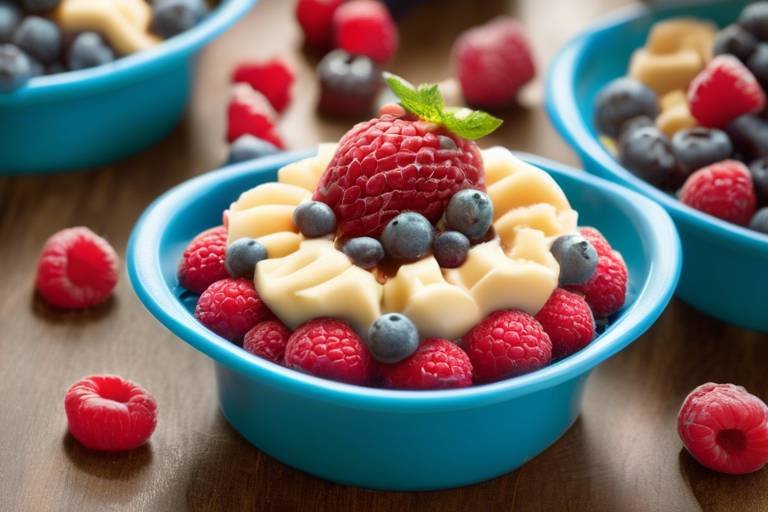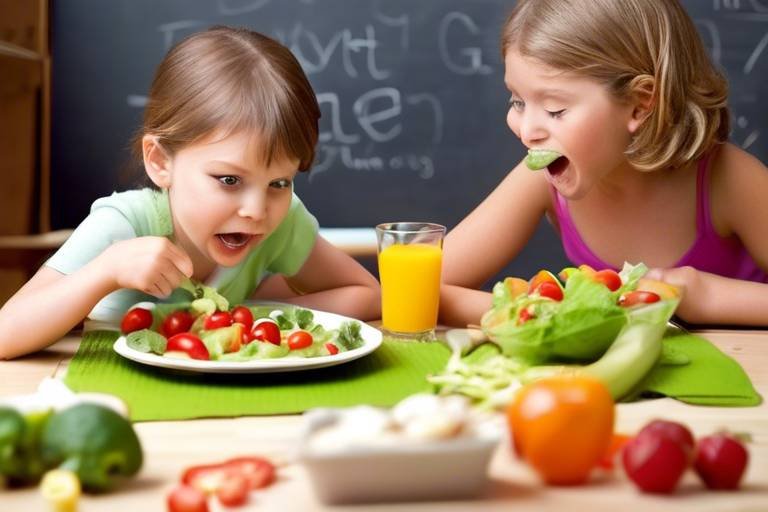The Importance of Protein in Your Kids' Diets
When it comes to our children's health, protein often takes a back seat to other nutrients like vitamins and minerals. But did you know that protein is a powerhouse nutrient that plays a crucial role in your kids' growth, development, and overall health? It's like the building blocks of their bodies, helping them to develop strong muscles, healthy organs, and even a resilient immune system. So, let’s dive into why protein should be a priority in your kids' diets and how you can easily incorporate it into their meals.
Protein is not just another nutrient; it's a fundamental component of every cell in your child's body. Think of it as the foundation of a house. Without a solid foundation, the house cannot stand strong. Similarly, without adequate protein, your child's body cannot function optimally. Protein supports a range of bodily functions, including:
- Growth and Development: Protein is essential for the growth of tissues and muscles. Children are constantly growing, and protein is vital for this process.
- Immune Function: Adequate protein intake helps bolster the immune system, keeping your kids healthy and fighting off illnesses.
- Hormone Production: Proteins are involved in the production of hormones that regulate various bodily functions, including metabolism and mood.
- Energy Levels: While carbohydrates are the body’s primary energy source, protein can also provide energy, especially during physical activities.
With all these benefits, it’s clear that protein is not just important; it’s essential for your child's overall well-being.
Now that we understand the importance of protein in your child's diet, let’s explore the many sources available. Protein can be found in both animal and plant-based foods, making it easier than ever to include in your family meals. Here’s a breakdown of some protein sources:
Animal-based proteins are often considered complete proteins, meaning they contain all the essential amino acids that the body cannot produce on its own. These proteins are typically found in:
- Meat: Chicken, beef, and pork are excellent sources.
- Dairy: Milk, cheese, and yogurt not only provide protein but also calcium for strong bones.
- Eggs: A versatile food that can be prepared in many ways, eggs are packed with protein and other nutrients.
Including these foods in your kids' meals can help ensure they receive the protein they need for optimal growth.
Red meat and poultry are particularly rich in iron and zinc, both of which are vital for growth and development. Iron is essential for transporting oxygen in the blood, while zinc supports immune function and wound healing. Aim to incorporate these meats into your family meals at least a few times a week. Consider making:
- Stir-fries: Quick and easy, just toss in some vegetables and your choice of meat.
- Tacos: Use ground beef or chicken and load them up with toppings!
- Grilled chicken: A healthy option that pairs well with various sides.
Dairy products are another fantastic source of protein. Milk, cheese, and yogurt are not only delicious but also provide calcium and vitamin D, which are essential for bone health. Try to include dairy in your kids' diets by:
- Adding milk to smoothies: A tasty way to boost protein intake.
- Using yogurt as a base for parfaits: Layer with fruits and granola for a nutritious snack.
- Incorporating cheese into sandwiches: A simple yet effective way to add protein to lunch.
Don’t forget about plant-based proteins! Foods like legumes, nuts, and whole grains are also excellent sources of protein. They can be particularly beneficial for vegetarian families or those looking to reduce meat consumption. Some great options include:
- Beans and Lentils: Rich in protein and fiber, perfect for soups and salads.
- Nuts and Seeds: Great for snacking or adding to cereals and yogurt.
- Quinoa: A complete protein that can be used in various dishes.
By diversifying protein sources, you can ensure your kids are getting a balanced diet that supports their growth and development.
Understanding how much protein your child needs daily is crucial for their growth. The amount varies based on age, activity level, and overall health. Here’s a quick look at the recommended protein intake:
| Age Group | Recommended Daily Protein Intake |
|---|---|
| Toddlers (1-3 years) | 13 grams |
| Children (4-8 years) | 19 grams |
| Children (9-13 years) | 34 grams |
| Teenagers (14-18 years) | 46-52 grams |
Keep in mind that these values are general guidelines, and individual needs may vary.
As children grow, their protein requirements change. It's essential to adjust their diet accordingly. For instance, toddlers may require less protein than active teenagers who are involved in sports. Here’s a closer look:
- Toddlers: Focus on protein-rich snacks like Greek yogurt or cheese cubes.
- School-aged children: Incorporate protein into meals with options like peanut butter sandwiches or chicken wraps.
- Adolescents: Encourage protein-rich meals post-workout, such as smoothies with protein powder or grilled chicken salads.
While protein is essential, it’s important to balance it with other nutrients in your child's diet. A well-rounded meal should include carbohydrates and healthy fats along with protein. Think of it like a team where each nutrient plays its part to ensure your child is healthy and energetic. For example, a plate could include:
- Grilled chicken (protein)
- Brown rice (carbohydrate)
- Steamed broccoli (fiber and vitamins)
By creating balanced meals, you can help your children thrive!
1. How can I ensure my child gets enough protein?
Incorporate a variety of protein sources into their meals, including both animal and plant-based options.
2. Is too much protein harmful?
While protein is essential, excessive amounts can lead to health issues. It's important to stick to recommended daily intakes.
3. Can vegetarian kids get enough protein?
Absolutely! With careful planning, vegetarian diets can provide all the necessary protein through legumes, nuts, seeds, and whole grains.
4. What are some quick protein-rich snacks for kids?
Some great options include yogurt, cheese sticks, hard-boiled eggs, and nut butter with fruit.

Understanding Protein's Role
Protein is often referred to as the building block of life, and for good reason! In children, it plays a crucial role in their growth and development. Think of protein as the construction crew that builds and repairs the body. Just like a house needs a solid foundation and sturdy walls, our kids need protein to develop strong muscles, bones, and organs. Without enough protein, children may not reach their full potential, both physically and mentally.
When kids consume protein, their bodies break it down into amino acids, which are essential for various bodily functions. These amino acids help in the production of enzymes and hormones, support immune function, and even transport nutrients throughout the body. Imagine amino acids as little messengers, delivering vital information and materials to different parts of the body to keep everything running smoothly.
Moreover, protein is essential for muscle development. As children grow and become more active, their muscles need the right nutrients to strengthen and recover from daily activities. This is particularly important for kids involved in sports or physical play. Just like a car needs fuel to run, children need protein to power their bodies and keep them functioning at their best.
Additionally, protein contributes to brain development. During childhood, the brain is rapidly developing, and it requires a variety of nutrients to thrive. Protein helps in the creation of neurotransmitters, which are vital for communication between brain cells. A well-nourished brain can lead to better focus, improved memory, and enhanced learning capabilities.
It's important to note that not all proteins are created equal. There are two main types: complete proteins and incomplete proteins. Complete proteins contain all nine essential amino acids that the body cannot produce on its own, while incomplete proteins lack one or more of these amino acids. Animal products like meat, dairy, and eggs are typically complete proteins, while many plant-based sources are incomplete. However, by combining different plant foods, such as beans and rice, parents can ensure their children receive all the necessary amino acids.
In summary, protein is a vital nutrient that supports growth, muscle development, and brain function in children. By understanding its role, parents can better appreciate the importance of incorporating a variety of protein-rich foods into their kids' diets. After all, a well-balanced diet is the key to a healthy and thriving child!

Sources of Protein
When it comes to fueling our little ones, protein is a powerhouse nutrient that should not be overlooked. It's like the building blocks of their bodies—essential for everything from growing muscles to repairing tissues. But where can we find this vital nutrient? Well, the good news is that there are numerous sources of protein suitable for children, ranging from animal products to plant-based options. Knowing these sources will empower parents to make informed dietary choices that support their kids' health and development.
Animal-Based Proteins are often the first that come to mind when we think of protein. These sources provide complete proteins, meaning they contain all the essential amino acids our bodies need. Foods like meat, dairy, and eggs are not only delicious but also packed with nutrients. For instance, red meat and poultry are rich in iron and zinc, both of which are vital for growth. Incorporating these into your child's diet can be as simple as adding a grilled chicken breast to their plate or mixing ground beef into a spaghetti sauce. The key is to ensure that the meat is lean and cooked properly to keep it healthy.
Red meat, such as beef and lamb, is an excellent source of protein, iron, and B vitamins. Poultry, like chicken and turkey, is also a fantastic option that tends to be lower in fat. The recommended servings for children can vary, but a good rule of thumb is to aim for about 2-3 servings of lean meats each week. You might consider:
- Including chicken in stir-fries or tacos.
- Using ground beef in homemade burgers or meatballs.
- Opting for lean cuts of pork for a healthy roast.
Dairy Products are another fantastic source of protein. Foods like milk, cheese, and yogurt not only provide protein but also calcium, which is essential for growing bones. A cup of milk offers about 8 grams of protein, while a serving of Greek yogurt can provide nearly double that! To include more dairy in your child's diet, consider:
- Starting the day with a smoothie made from yogurt and fruits.
- Offering cheese sticks as a snack.
- Incorporating milk into cereals or oatmeal.
Now, let’s not forget about plant-based proteins, which are equally important for a balanced diet. Foods like legumes, nuts, seeds, and whole grains can provide substantial protein and are often rich in fiber and other nutrients. For instance, lentils are a fantastic source of protein and can be easily added to soups, stews, or salads. Nuts and seeds can be sprinkled on yogurt or eaten as a snack. Remember, while plant proteins are great, they may not always provide complete proteins on their own, so pairing them with other protein sources can be beneficial.
In summary, whether you choose animal-based or plant-based proteins, the goal is to ensure your child is getting a variety of protein sources in their diet. This variety not only keeps meals interesting but also ensures they’re getting a broad spectrum of nutrients necessary for their growth and development.

Animal-Based Proteins
When it comes to fueling your child's growth and development, are like the superheroes of nutrition! They provide complete proteins, meaning they contain all the essential amino acids your little ones need to thrive. Think of proteins as the building blocks of the body—just like bricks are essential for constructing a sturdy house. Without these vital nutrients, your child's growth could be stunted, and their immune system might not function at its best.
Animal-based proteins, such as meat, dairy, and eggs, are packed with nutrients that support everything from muscle development to brain function. For instance, lean meats like chicken and turkey are not only rich in protein but also provide essential minerals like iron and zinc. These minerals are crucial for your child's energy levels and overall health. Dairy products, on the other hand, are a fantastic source of calcium, which is vital for strong bones and teeth.
But how much of these proteins should your kids be consuming? It’s essential to incorporate a variety of animal-based proteins into their diets. Here are some recommended servings:
| Food Source | Recommended Serving Size | Nutritional Benefits |
|---|---|---|
| Chicken Breast | 3 ounces | Rich in protein and low in fat |
| Ground Beef | 2 ounces | High in iron and zinc |
| Eggs | 1 large egg | Complete protein source and packed with vitamins |
| Greek Yogurt | 1 cup | High in protein and calcium |
Incorporating these animal-based proteins into meals can be as simple as adding grilled chicken to a salad or serving scrambled eggs for breakfast. The versatility of these proteins means you can mix and match them in various dishes, making mealtime exciting for your kids. For instance, consider trying:
- Chicken Tacos: Use shredded chicken, topped with cheese and veggies.
- Egg Muffins: Bake eggs with spinach and cheese in muffin tins for a fun breakfast.
- Yogurt Parfaits: Layer Greek yogurt with fruits and granola for a nutritious snack.
It's essential to remember that while animal-based proteins are incredibly beneficial, moderation is key. Too much red meat, for example, can lead to health issues down the line, so balancing these proteins with other food groups is vital. Encouraging a colorful plate filled with fruits, vegetables, and whole grains alongside animal proteins will not only enhance your child's diet but also make meals more appealing.
In conclusion, animal-based proteins are an integral part of a child's diet. They offer a wealth of nutrients that are essential for growth, development, and overall health. By incorporating a variety of these protein sources into your child's meals, you can help them build a strong, healthy foundation for their future!
1. How much protein do children need daily from animal sources?
The daily protein requirement can vary based on age, but generally, toddlers need about 13 grams, while school-aged children may require between 19 to 34 grams. It's best to consult with a pediatrician for personalized recommendations.
2. Are there any concerns with too much animal protein?
Yes, consuming excessive amounts of red or processed meats can lead to health issues. It's important to balance animal proteins with plant-based options and other food groups for a well-rounded diet.
3. What are some good ways to introduce animal proteins to picky eaters?
Try incorporating proteins into dishes they already enjoy, such as adding cheese to pasta or making smoothies with yogurt. Making the food visually appealing can also entice them to try new things!

Red Meat and Poultry
When it comes to ensuring that your kids get enough protein, are often the go-to options for many parents. These foods are not just tasty; they are also packed with essential nutrients that play a significant role in your child's growth and development. Red meat, such as beef and lamb, is rich in iron, which is crucial for forming red blood cells, while poultry, like chicken and turkey, is a lean source of protein that helps build and repair tissues.
Incorporating red meat and poultry into your child's diet can be both easy and delicious. For instance, you can prepare a hearty beef stew loaded with vegetables or whip up some chicken tacos that are not only fun to eat but also nutritious. The key is to make these meals appealing to your little ones, as children are often more willing to try new foods if they look and taste great.
Here are some benefits of including red meat and poultry in your child's diet:
- Rich in Essential Nutrients: Both red meat and poultry provide high-quality protein along with vital nutrients like zinc, iron, and B vitamins, which are crucial for energy production and overall health.
- Supports Growth: The protein found in these meats is essential for muscle development and overall growth, making it particularly important for active children.
- Versatile Cooking Options: From grilling to baking, there are countless ways to prepare red meat and poultry, ensuring that meals remain exciting and varied.
However, moderation is key. While red meat is beneficial, it’s important to choose lean cuts and avoid processed meats, which can be high in sodium and preservatives. Aim to balance red meat with other protein sources, such as fish and plant-based proteins, to provide a well-rounded diet. For poultry, opt for skinless options to reduce fat intake while still delivering the protein punch your kids need.
In terms of serving sizes, the USDA recommends that children aged 2 to 3 years consume about 2 ounces of meat or poultry per day, while older children may need up to 5 ounces depending on their age and activity level. This can be easily achieved by including a small portion of meat or poultry in each meal. For example, a typical dinner plate could feature grilled chicken breast alongside a side of quinoa and steamed vegetables, ensuring that your child receives a balanced meal that is rich in protein.
In conclusion, red meat and poultry are excellent sources of protein that can significantly contribute to your child's nutritional needs. By incorporating these foods into their diets thoughtfully and creatively, you can help support their growth and development while instilling healthy eating habits that will last a lifetime.

Dairy Products
Dairy products are not just delicious; they are also powerhouses of nutrition that play a crucial role in providing protein for growing children. Foods like milk, cheese, and yogurt are not only rich in protein but also packed with essential vitamins and minerals that are vital for a child's development. For instance, milk is a fantastic source of calcium, which is essential for building strong bones and teeth. But let's not forget about the protein! A single cup of milk contains about 8 grams of protein, making it an excellent choice for your little ones.
In addition to protein and calcium, dairy products are also rich in vitamin D, which helps the body absorb calcium more effectively. This combination is particularly important during the formative years when children's bones are growing and developing. Incorporating dairy into your child's diet can be as easy as adding a glass of milk with breakfast or a serving of yogurt as a snack. But what if your child is lactose intolerant? No worries! There are plenty of lactose-free options available, ensuring that all kids can enjoy the benefits of dairy without discomfort.
Furthermore, dairy products come in many forms, making it easy to include them in a variety of meals. Here are a few ideas on how to incorporate dairy into your kids' diets:
- Breakfast: Add milk to cereal or enjoy a smoothie made with yogurt and fruits.
- Lunch: Include cheese slices in sandwiches or pack a yogurt cup as a side.
- Dinner: Use grated cheese as a topping for pasta dishes or casseroles.
- Snacks: Offer cheese sticks or yogurt parfaits with fruits and granola.
It's important to choose low-fat or non-fat options when possible, as these can provide the same nutritional benefits without the extra calories. However, full-fat dairy can also be beneficial for younger children who need those extra calories for energy. The key is to find a balance that works for your child's age and activity level.
In summary, dairy products are an essential part of a child's diet, offering a delicious way to meet their protein needs while also providing other important nutrients. So, next time you're planning meals, consider how you can creatively include dairy to ensure your kids are getting the nutrition they need to thrive!
Q: How much dairy should my child consume daily?
A: The general recommendation is 2-3 servings of dairy per day for children, depending on their age and dietary needs. A serving can be a cup of milk, a slice of cheese, or a cup of yogurt.
Q: What if my child is lactose intolerant?
A: Many lactose-free dairy products are available, which can provide the same nutritional benefits without the discomfort. Additionally, fortified plant-based alternatives can also be good options.
Q: Are there dairy products that are better than others?
A: Low-fat or non-fat dairy options are generally recommended for older children, while full-fat dairy can be beneficial for younger children who need extra calories. Always look for options that are low in added sugars.

Plant-Based Proteins
When it comes to ensuring our kids get the protein they need, we often think of meat and dairy products. However, are equally vital and can be a fantastic addition to your child's diet. Not only are they packed with nutrients, but they also come with a host of other health benefits, such as being lower in saturated fat and higher in fiber. Imagine a world where your child’s meals are vibrant, colorful, and bursting with flavors, all while providing the essential protein their growing bodies require!
Plant-based proteins come from various sources, including legumes, nuts, seeds, and whole grains. These foods are not just protein-rich; they also contribute to a well-rounded diet that supports overall health. For instance, legumes like beans, lentils, and chickpeas are not only high in protein but also rich in fiber, which aids digestion and keeps kids feeling full longer. A single cup of cooked lentils can provide about 18 grams of protein, making them a powerhouse food for your little ones!
Let’s break down some of the most popular plant-based protein sources and how they can fit into your child’s meals:
- Legumes: These include beans, lentils, and peas. They can be added to soups, salads, or even made into delicious dips like hummus.
- Nuts and Seeds: Almonds, walnuts, chia seeds, and flaxseeds are great options. They can be sprinkled on yogurt, blended into smoothies, or eaten as a snack.
- Whole Grains: Quinoa, brown rice, and oats not only provide protein but also essential vitamins and minerals. Quinoa, for instance, is a complete protein, containing all nine essential amino acids.
Incorporating these foods into your child's diet doesn't have to be a chore. Think of it as an adventure in the kitchen! You can create colorful salads, hearty soups, or even fun snacks like energy balls made from oats and nut butter. Each bite can be a step towards a healthier lifestyle. Plus, involving your kids in the cooking process can make them more excited about trying new foods. After all, who wouldn’t want to devour a plate of rainbow-hued quinoa salad?
Another significant advantage of plant-based proteins is their versatility. They can be easily adapted into various cuisines and dishes, making meal prep a breeze. Whether it’s a bean burrito, a chickpea curry, or a nut butter smoothie, the options are endless. This variety not only keeps mealtime interesting but also ensures that your child is receiving a broad spectrum of nutrients.
In conclusion, incorporating plant-based proteins into your child's diet is not just beneficial; it’s essential. By introducing a mix of legumes, nuts, seeds, and whole grains, you can ensure that your kids are getting the protein they need while also enjoying delicious and nutritious meals. So, why not start today? Your little ones will thank you with every vibrant plate they devour!
1. Can my child get enough protein from a plant-based diet?
Yes! With a variety of legumes, nuts, seeds, and whole grains, children can easily meet their protein needs through a well-planned plant-based diet.
2. How can I ensure my child gets complete proteins from plant sources?
Combining different plant proteins, such as rice and beans, can provide all essential amino acids. This way, you ensure they get a complete protein profile!
3. Are there any potential downsides to a plant-based diet for kids?
While a plant-based diet is generally very healthy, it's essential to ensure that children are getting enough calories, vitamins, and minerals, particularly B12, iron, and omega-3 fatty acids, which can be lower in plant-based diets.
4. What are some easy plant-based protein recipes for kids?
Some simple recipes include lentil soup, chickpea salad, nut butter smoothies, and veggie stir-fry with tofu or tempeh.

Daily Protein Requirements
Understanding how much protein children need daily is essential for proper growth and development. Just like a car needs fuel to run smoothly, kids need protein to fuel their growing bodies. The amount of protein required can vary based on several factors, including age, weight, and activity level. In general, children require more protein as they grow, especially during periods of rapid development, such as during puberty.
According to the Recommended Dietary Allowances (RDAs), the protein intake for children varies by age group. For example, toddlers aged 1-3 years need about 13 grams of protein per day, while school-aged children aged 4-8 years require around 19 grams. As children enter their teenage years, their needs increase significantly; adolescents aged 14-18 years should aim for 46-52 grams of protein daily, depending on their sex and level of physical activity.
| Age Group | Daily Protein Requirement (grams) |
|---|---|
| 1-3 years | 13 grams |
| 4-8 years | 19 grams |
| 9-13 years | 34 grams |
| 14-18 years | 46-52 grams |
It's also important to remember that these numbers are not set in stone; children who are very active, such as those involved in sports, may require additional protein to support muscle repair and growth. Think of protein as the building blocks of their body, helping to create strong muscles, healthy skin, and even hormones. So, how can parents ensure that their kids are getting enough protein? One effective strategy is to include a variety of protein sources in their meals. This can include both animal and plant-based proteins, which we will explore in more detail in other sections of this article.
Balancing protein intake with other essential nutrients is equally important. While protein is crucial, kids also need carbohydrates for energy and fats for brain development. A well-rounded meal might consist of a lean protein source, whole grains, and plenty of fruits and vegetables. For instance, a delicious dinner could include grilled chicken, quinoa, and a side of steamed broccoli. This not only meets their protein needs but also provides a colorful array of vitamins and minerals.
In conclusion, keeping track of your child's protein intake is vital for their growth and health. By understanding their specific needs and incorporating a variety of protein-rich foods into their diet, parents can help ensure their children thrive during these formative years.
- What are the best sources of protein for kids?
Some of the best sources of protein include lean meats, dairy products, eggs, legumes, nuts, and seeds. These foods not only provide protein but also essential vitamins and minerals.
- Can kids get enough protein from a vegetarian diet?
Absolutely! Children can meet their protein needs through a well-planned vegetarian diet that includes beans, lentils, tofu, nuts, seeds, and whole grains.
- How can I tell if my child is getting enough protein?
Signs that a child may not be getting enough protein can include stunted growth, fatigue, and frequent infections. If you have concerns, consult a pediatrician for guidance.

Age-Specific Guidelines
When it comes to ensuring that your little ones are getting the right amount of protein, it’s not a one-size-fits-all situation. Different age groups have varying protein needs, and understanding these requirements is crucial for their growth and development. For instance, toddlers, who are often full of energy and curiosity, have different needs compared to school-aged children or teenagers. So, let’s break it down!
For toddlers aged 1 to 3 years, the recommended daily protein intake is about 13 grams. This is primarily because they are rapidly developing, and protein plays a key role in building tissues and muscles. Foods like yogurt, cheese, and soft meats can easily be introduced into their diets. A simple meal could include scrambled eggs with cheese and some soft fruit on the side. It’s not just about quantity; it’s also about making it appealing to their taste buds!
As children grow into the school-aged group, typically from 4 to 8 years, their protein needs increase to around 19 grams per day. At this age, kids are more active, and their bodies require more protein to support their growth spurts. Incorporating peanut butter on whole-grain bread or adding chicken to a salad can be great ways to meet their needs. It’s essential to make meals fun and colorful, encouraging them to try new foods while ensuring they get their protein fix.
Now, let’s not forget about adolescents, who are in a phase of significant growth and development. For boys aged 9 to 13 years, the daily protein requirement jumps to about 34 grams, while girls in the same age group need around 32 grams. During this time, protein becomes even more vital as it aids in muscle development and overall health. Teenagers often gravitate towards snacks, so providing protein-rich options like nuts, protein bars, or smoothies can be a game-changer. Remember, it’s about balance—pairing proteins with carbohydrates and healthy fats is key.
To help visualize these needs, here’s a simple table summarizing the protein requirements by age group:
| Age Group | Daily Protein Requirement |
|---|---|
| Toddlers (1-3 years) | 13 grams |
| School-aged (4-8 years) | 19 grams |
| Adolescents (9-13 years) | Boys: 34 grams Girls: 32 grams |
It’s important to note that these numbers can vary based on the child’s activity level. Active kids may require more protein to support their energy needs and muscle recovery. So, keep an eye on their activity levels and adjust their protein intake accordingly. Remember, the goal is to create a well-rounded diet that not only meets their protein needs but also includes a variety of nutrients to support their overall health.
1. What are some quick protein-rich snacks for kids?
Protein-rich snacks can include items like Greek yogurt, string cheese, hard-boiled eggs, or hummus with veggies. These are easy to prepare and can be packed for school lunches!
2. Can vegetarian kids get enough protein?
Absolutely! Vegetarian kids can meet their protein needs through legumes, tofu, quinoa, nuts, and dairy products. It’s all about variety and ensuring they consume a balanced diet.
3. What are some signs my child might not be getting enough protein?
If your child is feeling fatigued, losing weight, or showing signs of stunted growth, it might be worth checking their protein intake. Consulting with a pediatrician can provide personalized guidance.

Balancing Protein Intake
When it comes to your child's diet, is crucial. Just like a well-tuned orchestra, where each instrument plays its part to create a beautiful symphony, a child's diet needs the right balance of nutrients to support their growth and development. While protein is essential for building muscles and repairing tissues, it's not the only player in the game. Carbohydrates and fats are equally important, providing energy and supporting overall health.
So, how do you ensure that your child gets the right amount of protein without overshadowing other vital nutrients? It starts with understanding the food pyramid and how different food groups work together. For instance, a well-rounded meal might include a protein source, a healthy carbohydrate, and some fats, along with a variety of fruits and vegetables. This way, your child not only gets their protein fix but also a spectrum of vitamins and minerals that are essential for their well-being.
Here’s a simple breakdown of how to balance protein with other nutrients:
| Food Group | Examples | Role in Diet |
|---|---|---|
| Protein | Chicken, beans, yogurt | Builds and repairs tissues |
| Carbohydrates | Rice, bread, fruits | Provides energy |
| Fats | Nuts, avocados, olive oil | Supports cell growth and hormone production |
To create balanced meals, consider the following tips:
- Mix and match different protein sources. For example, pair chicken with brown rice and steamed broccoli for a complete meal.
- Incorporate healthy snacks that combine protein with carbohydrates, such as apple slices with peanut butter or yogurt with granola.
- Encourage your child to try new foods from each food group, making mealtime an exciting adventure!
It's also important to listen to your child's hunger cues. Children are great at self-regulating their intake if given the chance. If they’re not hungry for a big protein portion at dinner, don’t force it. Instead, offer smaller, protein-rich snacks throughout the day. Think of it like building a LEGO tower; each block is important, but the overall structure is what matters most.
Remember, the goal is to create a diet that supports your child's unique needs while keeping meals enjoyable. By focusing on a variety of foods and balancing protein with other nutrients, you can help your child thrive and grow into a healthy adult.
Q: How much protein should my child consume daily?
A: The recommended daily intake varies by age and activity level. Generally, toddlers need about 13 grams, while school-aged children require around 19 grams. Adolescents may need up to 34 grams per day, depending on their growth and activity levels.
Q: Can my child get enough protein from a vegetarian diet?
A: Absolutely! There are plenty of plant-based protein sources like beans, lentils, tofu, and quinoa. Just ensure they are consuming a variety of these foods to meet their protein needs.
Q: What are some good protein-rich snacks for kids?
A: Some excellent protein-rich snacks include Greek yogurt, cheese sticks, hard-boiled eggs, and nut butter on whole-grain toast. These snacks are not only nutritious but also delicious!
Frequently Asked Questions
- What is the role of protein in my child's diet?
Protein is crucial for your child's growth and development. It helps build and repair tissues, supports muscle development, and plays a vital role in producing hormones and enzymes. Think of protein as the building blocks for your child's body, ensuring they grow strong and healthy.
- How much protein does my child need daily?
The daily protein requirements vary by age. Generally, toddlers need about 13 grams, school-aged children require around 19 grams, and adolescents may need up to 34 grams of protein each day. It's essential to adjust these numbers based on their activity levels and overall health.
- What are some good sources of protein for kids?
There are plenty of protein-rich foods you can include in your child's diet! Animal-based sources include meat, poultry, fish, eggs, and dairy products like yogurt and cheese. For plant-based options, consider legumes, nuts, seeds, and whole grains. Variety is key to keeping meals exciting and nutritious!
- Can my child get enough protein from a vegetarian or vegan diet?
Absolutely! With thoughtful planning, vegetarian and vegan diets can provide sufficient protein. Foods like lentils, chickpeas, quinoa, tofu, and tempeh are excellent sources. Just ensure your child consumes a mix of these foods to get all the essential amino acids needed for growth.
- How can I encourage my child to eat more protein?
Making protein fun can be a game-changer! Try involving your kids in meal prep, letting them choose protein-rich snacks, or creating colorful plates with a variety of protein sources. You might also experiment with fun recipes like protein-packed smoothies or homemade protein bars!
- Is it possible for my child to eat too much protein?
While protein is essential, too much of it can lead to health issues like dehydration or kidney strain. It's crucial to balance protein intake with other nutrients like carbohydrates and fats. Always consult with a pediatrician if you have concerns about your child's diet.

